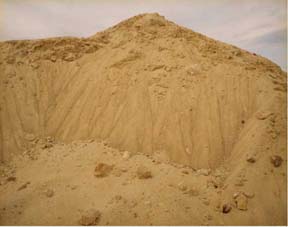Josh Winer’s show at Clifford Smith Gallery exhibits 30” x 40 “ C–prints of piles of sand and gravel. The photographs, shot with a 4x5 camera and mounted on aluminum, are reminiscent of western traditional landscape: but with a twist. When you first enter the gallery, images of what could be sand dunes in the Mohave Desert expand across the wall. Upon closer inspection of each image, the illusion of timeless traditional landscape breaks down.
Winer constructs images such as 42° 14’ 36N, 071° 02’ 59W by drawing on the visual language used by landscape photographers exemplified by Ansel Adams. However, while traditional landscape can be viewed as sublimely beautiful and ageless, Winer’s photographs are all in a process of transition. Winer also titles his work by their GPS (Global Positioning System) location, unlike Adams who titled his work to emphasize the romantic (such as Winter Sunrise from Lone Pine). This romantic notion of landscape is one without death or decay and simultaneously without people. For example, Adams’ image Mt. Robson could be described as showing the beauty of “untouched nature” without flaws or destruction. Have you ever been to a national park without port-o-potties or a dead raccoon in the road? Traditional types of landscape exist in denial of the unavoidable progress of industry and encroaching population growth. Winer’s images point directly at the signs of capitalism and consumerism missing from previous landscape tradition. He does this by showing signs of humanity such as footprints and tire tracks. Winer’s sand piles reflect the human desire to construct our own landscape, to mold it and move it into place.
However, Winer’s work does not lose the sense of sublime found in traditional landscape. By filling the frame from edge to edge, Winer creates a sense of being engulfed by the image as if the sand could slide off of the wall in front of you. Unlike the mountains of early landscape photographs that are often in the distance, Winer places the viewer at the foot of the piles of sand blocking the viewer from a wider point of view. Adams’ photographs would have had a river flowing where Winer has tire tracks pressing the dirt into place. Looking at Josh Winer’s images makes me think of the many years of piles we will have to look at driving by the Big Dig everyday. That ever-changing landscape will go on, and on, and on. Maybe after seeing Winner’s work we can develop an appreciation for it instead of just frustration.
Winer’s work references many other landscape traditions like Katsushika Hokusai’s Japanese prints, 36 views of Mt. Fuji. Towering in the background of the image South Wind, Clear Weather is a mountain but there are no other visual references in which to locate the landscape. Without the titles of Winer’s pieces we would have no frame of reference in which to locate his landscapes. Both seem to be visually describing change and landscape as reflection of life and progress while showing the constant of the landscape as well. In Hokusai’s prints Mt. Fuji is the constant, in Winer’s photographs knowing that the piles will change is the only constant. In Hokusai’s image, Mt Fuji from Ejiri, there are people walking along the path and the wind is blowing and the people are fighting to hang onto their possessions. Winer’s images have a similar sense of tension of impending and inevitable change. Winer’s photographs have been given an exact geographical location but we do not know how long it will be there. His photographs have a feeling of temporality that gives them life. Winer’s landscapes exist for a short period of time and then trucks come and move them into a new location and a new form. They become a new landscape with a new life, resulting in a new image. This ability to express change gives Winer’s work a sense of reality that can also be found in the prints of Hokusai, but it is harder to find in an Ansel Adams photograph. How can Adams’ images have any life when they insist upon never changing? Ansel Adams can give us nostalgic images of places that are untouched and Winer’s photographs have the ability to show a more tangible relationship between landscape and the modern world. Temporary as these sand piles might be we have the chance to experience them through Winer’s photographs, and when you are standing in the gallery looking at Winer’s work, think about what the GPS coordinate for Clifford Smith Gallery is!
Links:
Clifford Smith Gallery
"Josh Winer: Photographs" is on view until October 30th at Clifford Smith Gallery, 450 Harrison Ave., Boston.
All images are courtesy of the Josh Winer and Clifford Smith Gallery.
Heidi M. Marston is a new contributor to Big, Red & Shiny.



